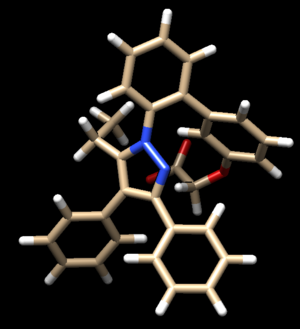2019 DOCK GA tutorial 1 with 2NNQ
For this experiment required files will include 2NNQ.lig.mol2. Make sure that you use a charged ligand with hydrogens
I. Fragment Library Generation for 2NNQ
Fragment Libraries
For this experiment a general fragment library to account for all the possible ligands the GA can produce. A focused Fragment library will not be enough to account for all the possibilities since it is too small of a set of data.
The first step for this experiment is to generate a directory to perform the work in
mkdir 2NNQ_GA
Go into this new directory and then create another directory that will store all the fragment molecules
mkdir fraglib
Enter the file directory fraglib
cd fraglib
Create a new file called 2NNQ.fraglib
touch 2NNQ.fraglib
dock6 -i 2NNQ.fraglib
Answer the following prompts using these responses
conformer_search_type flex
write_fragment_libraries yes
fragment_library_prefix 2NNQ.fraglib
fragment_library_freq_cutoff 1
fragment_library_sort_method freq
fragment_library_trans_origin no
use_internal_energy no
ligand_atom_file ../../2NNQ_Tutorial/1.dockprep/2nnq_lig_withH.mol2
limit_max_ligands no
skip_molecule no
read_mol_solvation no
calculate_rmsd no
use_database_filter no
orient_ligand no
bump_filter no
score_molecules no
atom_model all
vdw_defn_file /gpfs/projects/AMS536/zzz.programs/dock6/parameters/vdw_AMBER_parm99.defn
flex_defn_file /gpfs/projects/AMS536/zzz.programs/dock6/parameters/flex.defn
flex_drive_file /gpfs/projects/AMS536/zzz.programs/dock6/parameters/flex_drive.tbl
ligand_outfile_prefix 2NNQ_frag_output
write_orientations no
num_scored_conformers 1
rank_ligands no
The only aspect that is relevant of this fragment library generated is the torsion environment that should be titled 2NNQ.fraglib_torenv.dat Following this step the torsion environments of this molecule will be combined with the file titled full_sorted_fraglib.dat using the python software combine_torenv.py
python ${DOCK_DIR}/bin/combine_torenv.py 2NNQ.fraglib_torenv.dat ${DOCK_DIR}/parameters/fraglib_torenv.dat
This should generate a new list of torsion environments titled unique_full_sorted_fraglib.dat
II. Performing a GA using 2NNQ
For this part a new directory will be created in the 2NNQ_GA. This will just be 2NNQ_GA_results. cd into that directory and create a new file titled 2NNQ_GA.in.
mkdir 2NNQ_GA_results
cd 2NNQ_GA_results
touch 2NNQ_GA.in
Following this dock6 will be performed on the molecule
dock6 -i 2NNQ_GA.in -o 2NNQ_GA.out
Input the following in order to get the GA working properly. The file will ask for ga_mutations. This will prompt you with addition, deletion, substitution, and replacement mutations and respond yes to all them unless there is a specific purpose to your code to not include these mutation types.
conformer_search_type genetic
ga_molecule_file /Path/2nnq_lig_withH.mol2
ga_fraglib_scaffold_file /gpfs/projects/rizzo/zzz.programs/dock6.10_2019.06.14/parameters /fraglib_ga_scaffold.mol2
ga_fraglib_linker_file /gpfs/projects/rizzo/zzz.programs/dock6.10_2019.06.14/parameters /fraglib_linker.mol2
ga_fraglib_sidechain_file /gpfs/projects/rizzo/zzz.programs/dock6.10_2019.06.14/parameters/fraglib_sidechain.mol2
ga_torenv_table ../fraglib/unique_full_sorted_fraglib.dat
ga_max_generations 500
ga_xover_sampling_method_rand yes
ga_xover_max 150
ga_bond_tolerance 0.5
ga_angle_cutoff 0.14
ga_check_overlap no
ga_mutations yes
ga_mutate_addition yes
ga_mutate_deletion yes
ga_mutate_substitution yes
ga_mutate_replacement yes
ga_mutate_parents yes
ga_pmut_rate 0.3
ga_omut_rate 0.7
ga_max_mut_cycles 5
ga_mut_sampling_method rand
ga_num_random_picks 10
ga_max_root_size 5
ga_energy_cutoff 100
ga_heur_unmatched_num 2
ga_heur_matched_rmsd 2
ga_constraint_mol_wt 550
ga_constraint_rot_bon 10
ga_constraint_H_accept 10
ga_constraint_H_don 5
ga_constraint_formal_charge 4
ga_ensemble_size 200
ga_selection_method elitism
ga_elitism_combined no
ga_elitism_option max
ga_niching no
ga_selection_extinction no
ga_max_num_gen_with_no_crossover 1000
ga_output_prefix 2NNQ_GA_output
use_internal_energy yes
internal_energy_rep_exp 12
internal_energy_cutoff 100
use_database_filter no
orient_ligand no
bump_filter no
score_molecules yes
contact_score_primary no
grid_score_primary no
gist_score_primary no
multigrid_score_primary no
dock3.5_score_primary no
continuous_score_primary no
footprint_similarity_score_primary no
pharmacophore_score_primary no
hbond_score_primary no
descriptor_score_primary yes
descriptor_use_grid_score no
descriptor_use_multigrid_score no
descriptor_use_continuous_score no
descriptor_use_footprint_similarity no
descriptor_use_pharmacophore_score no
descriptor_use_tanimoto no
descriptor_use_hungarian no
descriptor_use_volume_overlap no
descriptor_use_gist no
minimize_ligand yes
minimize_anchor yes
minimize_flexible_growth yes
use_advanced_simplex_parameters no
simplex_max_cycles 1
simplex_score_converge 0.1
simplex_cycle_converge 1
simplex_trans_step 1
simplex_rot_step 0.1
simplex_tors_step 10
simplex_anchor_max_iterations 500
simplex_grow_max_iterations 500
simplex_grow_tors_premin_iterations 00
simplex_random_seed 0
simplex_restraint_min yes
simplex_coefficient_restraint 10
atom_model all
vdw_defn_file /gpfs/projects/AMS536/zzz.programs/dock6/parameters /vdw_AMBER_parm99.defn
flex_defn_file /gpfs/projects/AMS536/zzz.programs/dock6/parameters/flex.defn
flex_drive_file /gpfs/projects/AMS536/zzz.programs/dock6/parameters/flex_drive.tbl
For the last step send this to the slurm servers generate the results. This test will occur for 500 generations and is too computationally intensive for the head node.
First create a new file to send to the slurm system
vim 2NNQ_GA.sh
Following this input the following into the 2NNQ_GA.sh script
#!/bin/bash
#SBATCH --time=48:00:00
#SBATCH --nodes=1
#SBATCH --ntasks=40
#SBATCH --job-name=2NNQ_GA_input
#SBATCH --output=2NNQ_GA_output
#SBATCH -p long-40core
cd $SLURM_SUBMIT_DIR
dock6 -i 2NNQ_GA.in -o 2NNQ_GA.out
Following this you will send the script
qsub 2NNQ_GA.sh
To check on its status use the following
qstat -u username
